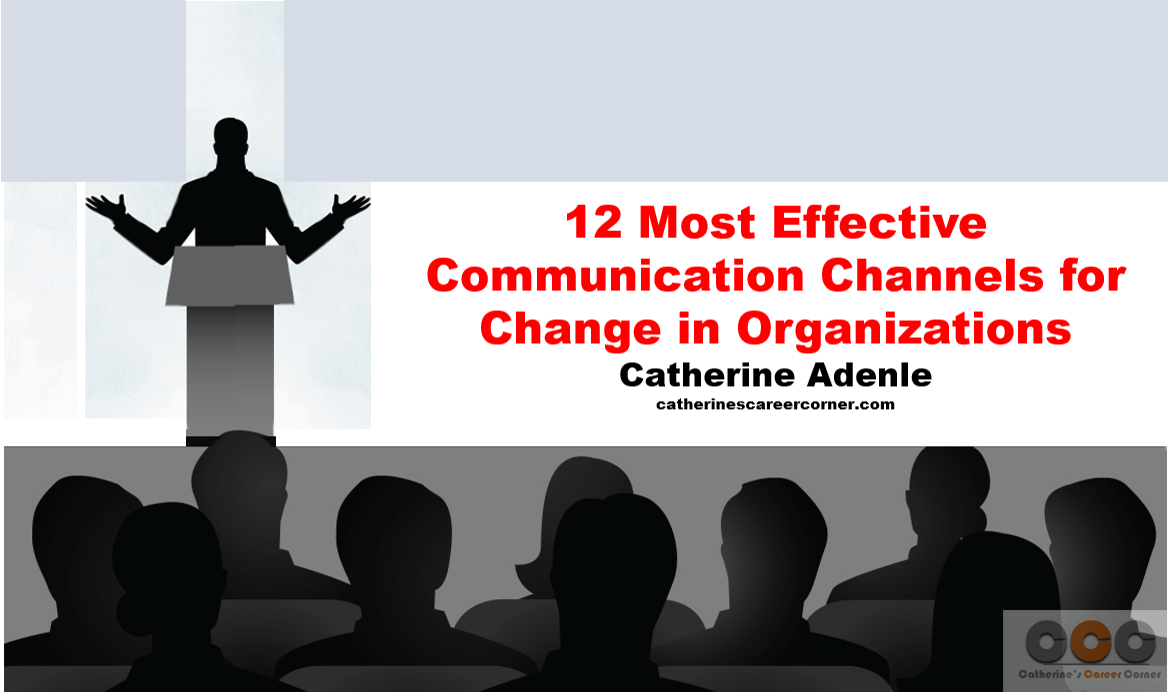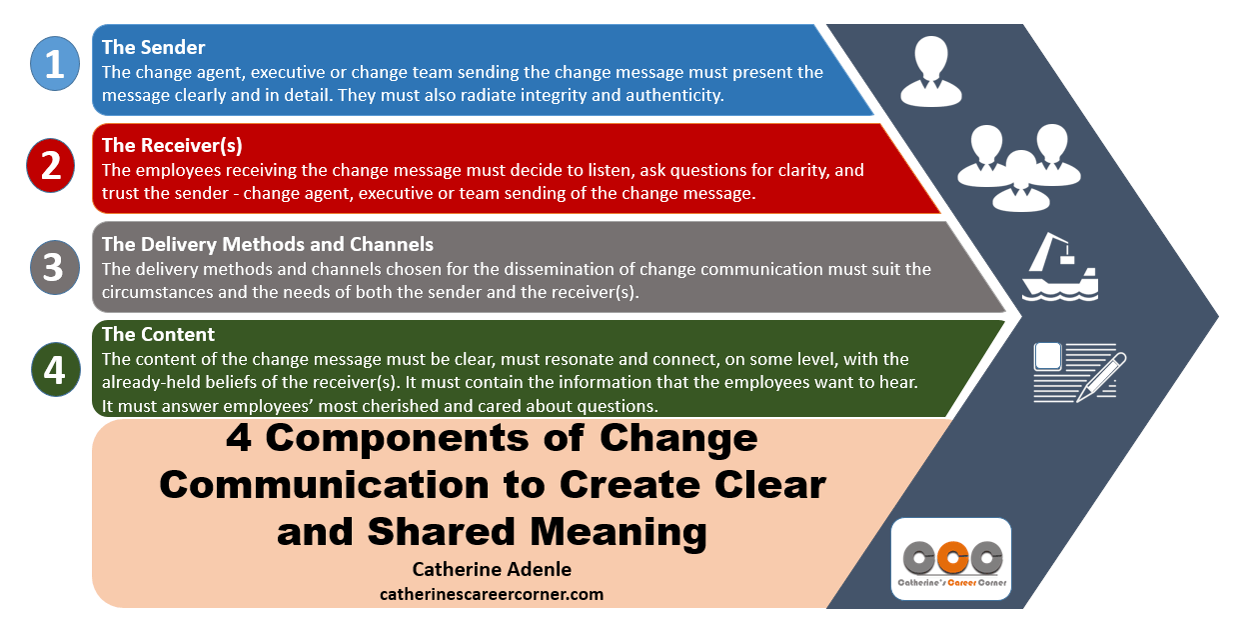
By Catherine Adenle
These are the 12 most effective communication channels for change in organizations if you need to communicate change at work? Nothing derails change in organizations like poor communication does.
The frequency of change and the lack of success in how organizations implement change can make change management process seem overwhelming for leaders and change agents. Communication is at the core of change if employees are to embrace and commit to the change. Hence it is important to also have a communication plan, know how to craft change messages as well as know these tried and tested 12 most effective communication channels for change.
With an effective change communication plan, an organization can manage the people side of change effectively as well as the business side. Another important aspect of change communication is knowing how best to share or disseminate change information. A critical piece of this knowing the right tried and tested the most effective and best channels to use. For this, no one it is vital to know that no one channel fits all in organizations when communicating change.
‘The organization that can’t communicate can’t change, and the organization that can’t change is dead.’ – Nido Qubein, Author and Chairman of McNeill Lehman
“70% of change initiatives in organizations fail.” – McKinsey & Company
Change is everywhere we turn. All organizations go through change and the causes may be internal or external. As no organization can exclude itself from these periods of change, it’s critical for them to have a plan and strategy to deal with communication during these periods of change. Knowing the 12 most effective communication channels for change is equally as important as knowing how to craft effective change information or messages.
Effective change communication and methods of dissemination create clarity and meaning
First, the primary use of communication during change is to create clarity. Secondly, an organization needs to know the best way to structure change communication so that it is clear and meaningful. Finally, it is equally vital that an organization uses what they see as the most effective channels to disseminate such change communication.
In your organization, if your task is to communicate change, ensure that you understand the details of the change yourself. What are the ‘4Ws and How’ of the change? To introduce change, communicate using the answers to – What?, Why?, Who?, When? and How? to all affected employees. Build a ‘Change Communication Team,’ made up of nominated employees with great communications skills from the onset. Create and utilize a communication workflow map of how to disseminate consistent, clear and continuous change information by the team or you throughout the change period. Then, think of the best ways to let everyone understand what your organization is trying to achieve through change and through your communication. In addition, ensure that every one the change will affect has access to your verbal and written communication by using these 12 most effective communication channels for change in organizations.
Communication is key in turning any change expectation into reality. Change communication is both organizational (one to many, or many to many) as well as interpersonal (one-to-one). In either case, change communication needs to be clear, concise, frequent, purposeful, ongoing and easily accessible.
See 12 Reasons Why Employees Resist Change in the Workplace
Why is change communication one of the most difficult aspects of change?
Well, every successful change agent or executive, who has led a successful change management effort, will express the need for over-communicating during any change. This is the reason why people say the people part of the change as well as communication of change is the two most difficult aspects of change management.
As everyday communication in the workplace is one of the toughest issues in most organizations, then imagine how difficult it is for most organizations to combine change communication with their agenda of things to communicate to employees. Remember, employees, detest change or what they see as disruptive to their usual routine at work. We all belong to a society steeped in change and the thought of any change could be de-stabilising for most of us.
Frankly, change communication plus methods of dissemination are major areas that are frequently complained about by employees during organizational change and during daily operations. Why? This is because effective change communication requires 4 major components that are inter-connected perfectly to create a clear and shared meaning. To communicate change, if one of these 4 components are not properly executed, the likelihood of the change failing is high.
The communication diagram presented below shows how effective communication influences the stakeholders – especially employees when building commitment towards the change.
Organizations that communicate effectively during change are far more likely to implement change successfully and report high levels of employee engagement during change.
4 Components of clear and meaningful change communication
Communication is key when an organization tries to raise the level of understanding of employees during change. The key to communicating change successfully is to use multiple channels or vehicles to communicate the same message. To do this, an organization needs to know about these 4 components of clear and meaningful change communication:
See Implement Sustainable Change: 5 Key Elements (Infographic) and The Importance of Communication Skills [Top 10 Studies]
Using the right channels to communicate change is vital
Countless change management efforts fail because of poor communication. An organization may have the best change plan, utilize the best change models, have the best change business cases and the employees that are looking to adopt the change, but if the communication and access to change information is hidden, then, all the efforts put into making the change happen will not yield enough dividend. No organization can ignore change communication and how to distribute it in a timely manner if they are asking their employees to make a change.
The importance of change communication outlets needs attention. For change to happen and stick, all organizations must commit to improving people’s understanding of what, why, how, when and who of change. To make sure that employees have access to change communication and understand the change information they are given, there is the need to use these 12 most effective communication channels for change in organizations as shown on the Infographic below.
During the change, it’s important to include all employees so that they get involved in decisions that affect them. Everyone has the right to communicate and ask questions. Communication is the exchange and flow of information and ideas from one person to another. It is a two-way process and if there is a difficulty, gap or breakdown in change communication, there is every probability that the change will fail.
For change communication and transmission in organizations, one channel does not fit all. We know that some people need information in a different format to fully understand the information being transmitted. For change communication, make a variety of communication pathways and channels available for use once change information is carefully and clearly crafted.
12 most effective communication channels for change in organizations
These are the 12 most effective communication channels for change in organizations:
Infographic: 12 most effective communication channels for change in organizations
Inclusive communication via various channels helps organizations to share change information in a way that everybody can understand it. This enables employees to access information and express themselves in any way they find easiest too.
Knowing and using these 12 most effective communication channels for change in organizations will:
Effective communication includes using effective channels
No change program goes completely according to plans. For this reason, change communication and methods of dissemination are crucial. Employees will react in unexpected ways to change. There will be areas of anticipated resistance and questions that require answers.
Effectively managing change requires a continual reassessment of change communication impact and the organization’s willingness and ability to adapt to the next wave of transformation. Armed with the support of leaders, the involvement and inclusion of employees, effective communications and access to all real information and data from the field to support the change, whoever is managing change communication can make the adjustments necessary to maintain momentum and drive results.
For more information on effective ways to engage employees during change through communication and other necessary ways, see 20 Effective Ways to Involve and Support Employees During Organizational Change from Catherine Adenle
| Change communication must be timely, straightforward, true, and consistent. Must contain reasons for the change, the plan, what it needs to achieve, and a question and answer segment. Organizations must not make an enormous mistake in using only one channel, such as e-mail or just the company intranet site to communicate change. One cap does not fit all when it comes to change communication and how information is transmitted and received. |
Now that you know the 12 most effective communication channels for change in organizations, what else can you add? Feel free to share your feedback by leaving a comment below.
This site uses Akismet to reduce spam. Learn how your comment data is processed.

This is a good Infographic to explain how best to communicate change. I just wish organizations and leaders are aware that dropping change on people’s lap by email on Friday afternoon without any prior warnings is not a smart thing to do.
This is a fantastic change and communications piece. Both will fail if not planned well and conconrrently. Change without proper communication plan or the right channel to fennel the change through will fail. Thanks for the article.
Absolutely spot on. I wish every manager out there involved in change management at work, will read this today. The level of stress most employees face at work during change can be reduced or eliminated.
Do you think lack of honesty from management about the level and impart of the change, hinders them from communicating change properly using the Ws and H?
Thanks
Hey Danny, thanks for an insightful comment. Indeed, a lack of honesty from leaders about the level of disruption or how any change will affect employees will definitely hinder how management communicates change using the Ws and H. A transparent approach and employees’ involvement will generate hidden solutions, drive understanding and promote buy-in.
Pingback: 8 Erros que os Empreendedores Cometem na Hora de Formar a Equipe